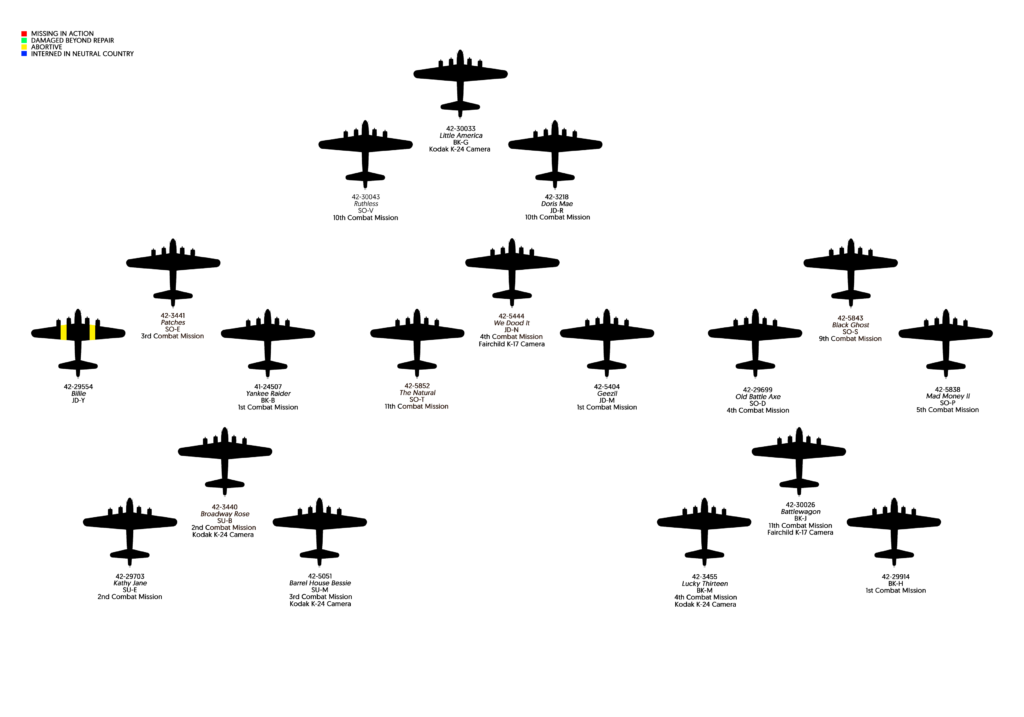77 years ago today, Lucky Thirteen flew her fourth combat mission.
27 August 1943
VIII BC No. 84
Ramrod S. 8
384BG No. 18
The US 8AF launches 224 Boeing B-17s, escorted by 173 Republic P-47s, against the Blockhaus d’Éperlecques (Bunker of Éperlecques) near Watten, France. Additional escort is provided by RAF 11 Group. The 384BG launches eighteen aircraft this day, the group being led by Operations Officer MAJ Alfred C. Nuttall aboard Little America (42‑30033). Lucky Thirteen flies in the number three position of the low squadron’s second element. This is the first strike made by the 384BG since the disastrous attack against Schweinfurt on 17 August.
This is also the first US strike of Operation CROSSBOW – the Allied bombing of German missile sites in occupied-Europe.
Germany had poured funding into its Vergeltungswaffen (Reprisal Weapon) program following the failure of the so-called “Baedeker Blitz” in 1942, by the end of the year successfully testing their first V-1 cruise missile (1,870 lb warhead) and supersonic V-2 ballistic missile (2,200 lb warhead). When Allied reconnaissance aircraft observed the construction of launch sites in northern France on 16 May 1943, serious consideration was given to diverting the bombing offensive toward these targets. Concerned over the possibility of chemical and gas attacks, Operation CROSSBOW was formally enacted on 17 August, with RAF BC bombing the V-2 research facility on Peenemünde. The attack was a massive success, thanks largely to Polish laborers who smuggled out maps and other intelligence from the facility.
This day’s attack on Watten targets the Kraftwerk Nord West (Powerplant North West) bunker complex, which is still under construction. Designed as a V-2 launch site, the facility is theoretically capable of housing over 100 missiles, being able to assemble and fuel them in-house. Once in operation, the Blockhaus d’Éperlecques is expected to launch an estimated 36 missiles a day. The US Army Air Forces are hesitant to participate in Operation CROSSBOW, the general consensus being that US air operations were better spent against targets crucial to the German economy and war effort. With pressure from the British government mounting, a consensus is reached where the US will target CROSSBOW targets only during periods of bad weather. As such, US attacks on German missile sites become known amongst bomber crews as “No Balls.”
Despite being made up to the same standards as the infamously strong German U-boat pens, this day’s strike against the Blockhaus d’Éperlecques is surprisingly successful. With construction still underway, the concrete had not yet dried – resulting in much of the concrete only drying AFTER it had been bombed. This was intentional. Sir Malcolm McAlpine, head of Sir Robert McAlpine Ltd. – a British construction firm – suggested timing the attack in this manner when consulted by Allied planners .
Due to a failure in the lead aircraft’s autopilot system, the 384BG fails to drop. Unable to go around due to the line-astern nature of the strike, the bombs are flown back home.
The numbers:
| Bombers Launched: | 224 |
| Bombers Effective: | 187 |
| Fighters Launched: | 173 |
| Bombers MIA: | 4 |
| Bombers DBR: | 1 |
| Bombers Abort: | 37 |
| Fighters MIA: | 1 |
| Abort Rate: | 17% |
| Loss Rate: | 2% |
| E/A Destroyed: | 7 |
*Please note that the numbers above come from official US and German sources as victory claims cannot be relied upon. The numbers above do not account for RAF statistics.
RAF 11 Group loses four Supermarine Spitfires in today’s escort operations.
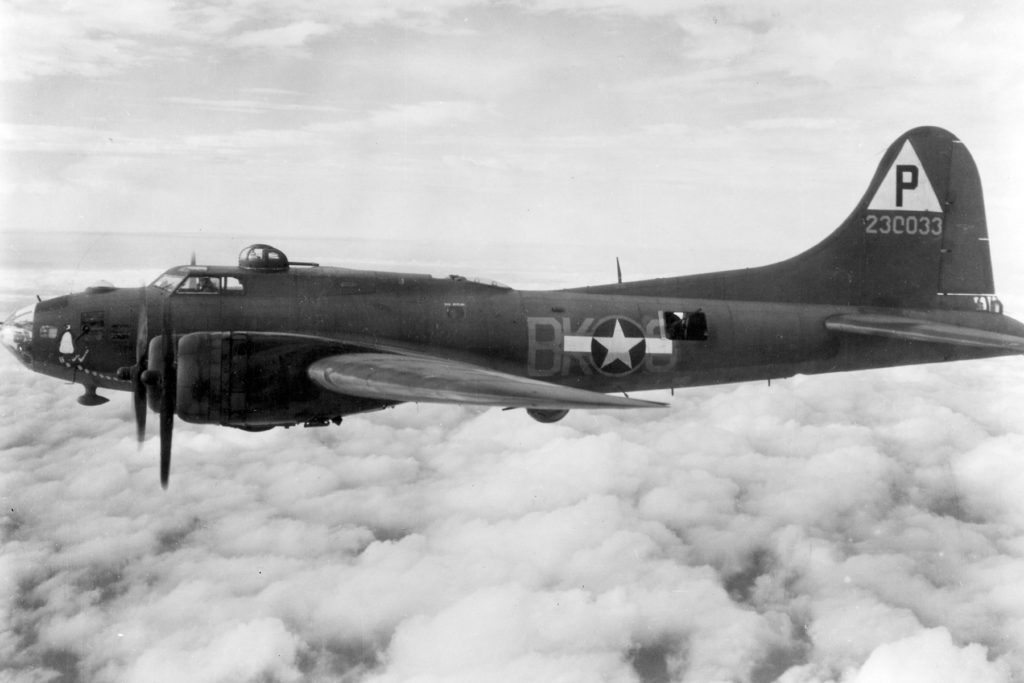
The 384BG’s lead bomber on this strike: Little America (42‑30033).
This aircraft completed 22 combat missions before lost on 1 December 1943 over Prüm, Germany with a different crew.
The 384BG’s formation chart from this day.
Billie (42-29554) aborts shortly after takeoff when one of her bombs falls off its shackle. Precariously rolling around on top of the bombbay doors, the load is dropped over the North Sea and Billie returns home.
Lucky Thirteen suffers a minor mechanical problem of her own, with one of the ball turret’s hydraulic transmissions developing a leak which causes the guns to creep when fired. Since Sperry-designed turrets used electric motors to power hydraulic transmissions, the leaky transmission was simply replaced upon return. Records from her next combat mission (31 August) reveal that her ball turret was still “running slow.”
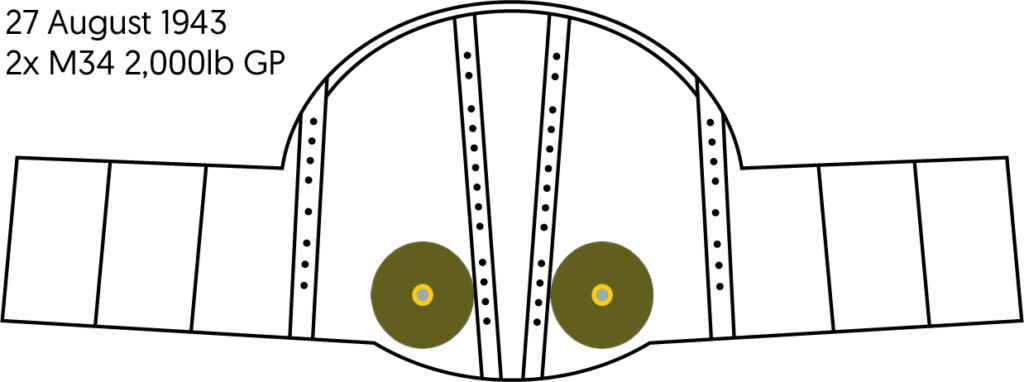
The AN-M34 2,000 lb GP was the largest bomb capable of being carried internally by the Boeing B-17. With the Blockhaus d’Éperlecques being a “hard target,” these 2,000 lb bombs are carried in the hope of penetrating the bunkers’ thick concrete.
It is doubtful the strike would have been a success had the concrete hardened prior. The US lagged behind the RAF in high-capacity bombs, never mass-producing any bomb larger than the 4,000 lb AN-M54. In contrast, the RAF successfully introduced its 12,000 lb “Tallboy” and 22,000 lb “Grand Slam” bombs over the next two years, having much success against fortified targets due to the “earthquake” effect.
The Blockhaus d’Éperlecques is written off as a launch site after the attack of 27 August 1943, with a portion repaired afterward as a rocket fuel storage facility. The site is finally abandoned in July 1944 after a series of Tallboy strikes that summer.
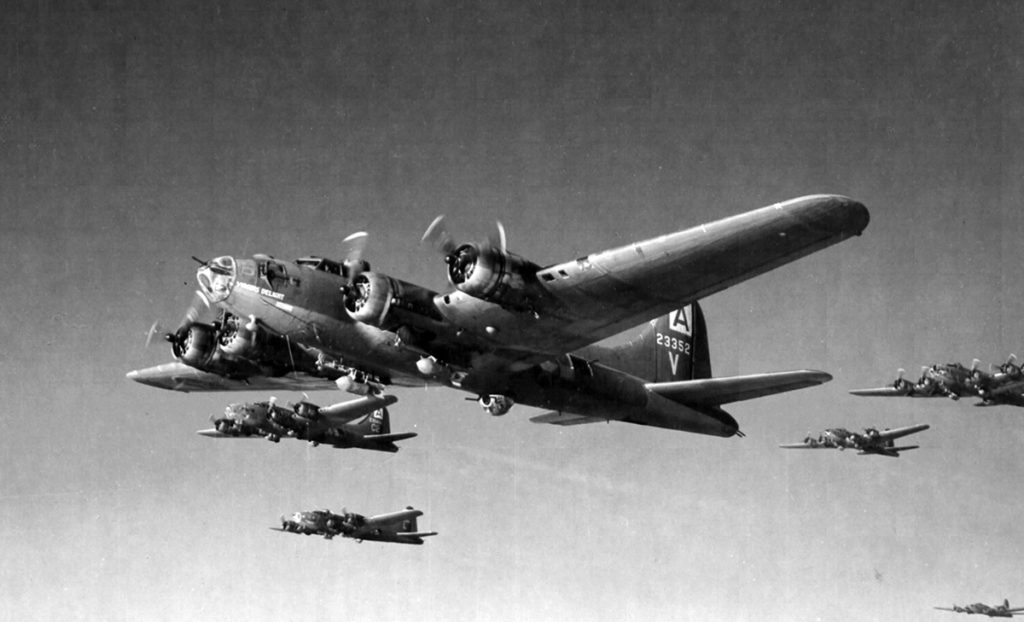
Virgin’s Delight (42-3352) carries an external pair of AN-M34s on the strike of 27 August 1943. The B-17 was capable of carrying up to 8,000 lbs on a pair of rarely-used external wing racks, however the aircraft’s maximum bombload of 14,000 lbs severely limited the B-17’s range and altitude.
Virgin’s Delight was shot down on 29 November 1943 over Solingen, Germany. Only her pilot, 2LT Walter Chyle, Jr., survived.
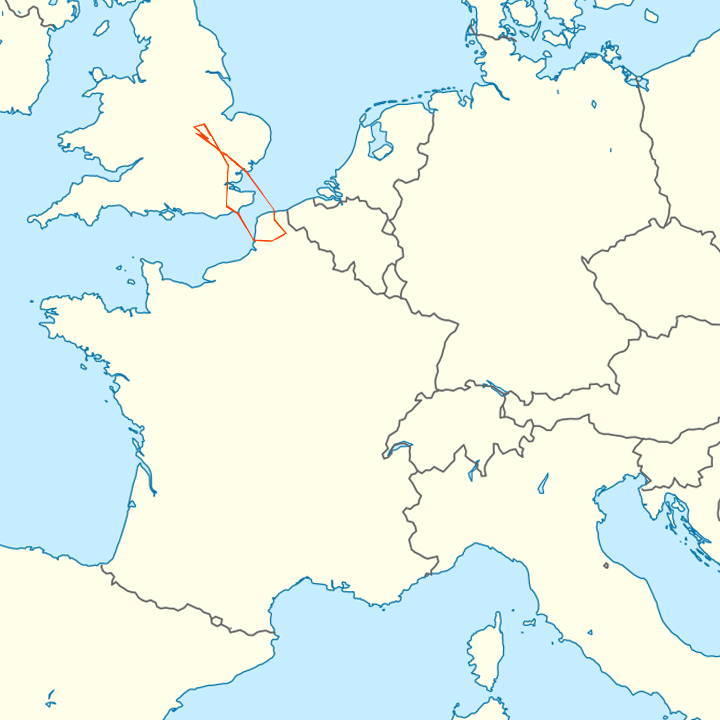
The 384BG’s strike route for 27 August 1943. The target was bombed at an altitude of 16,000 ft. Average temperature was -20 degrees.
All times in PM.
| Engine Start: | 3:55 |
| Taxi: | 4:10 |
| Takeoff: | 4:25 |
| Feet Wet: | 6:10 |
| Feet Dry: | 6:24 |
| IP: | 6:40 |
| Target: | 6:52 |
| Feet Wet: | 6:56 |
| Home: | 7:50 |
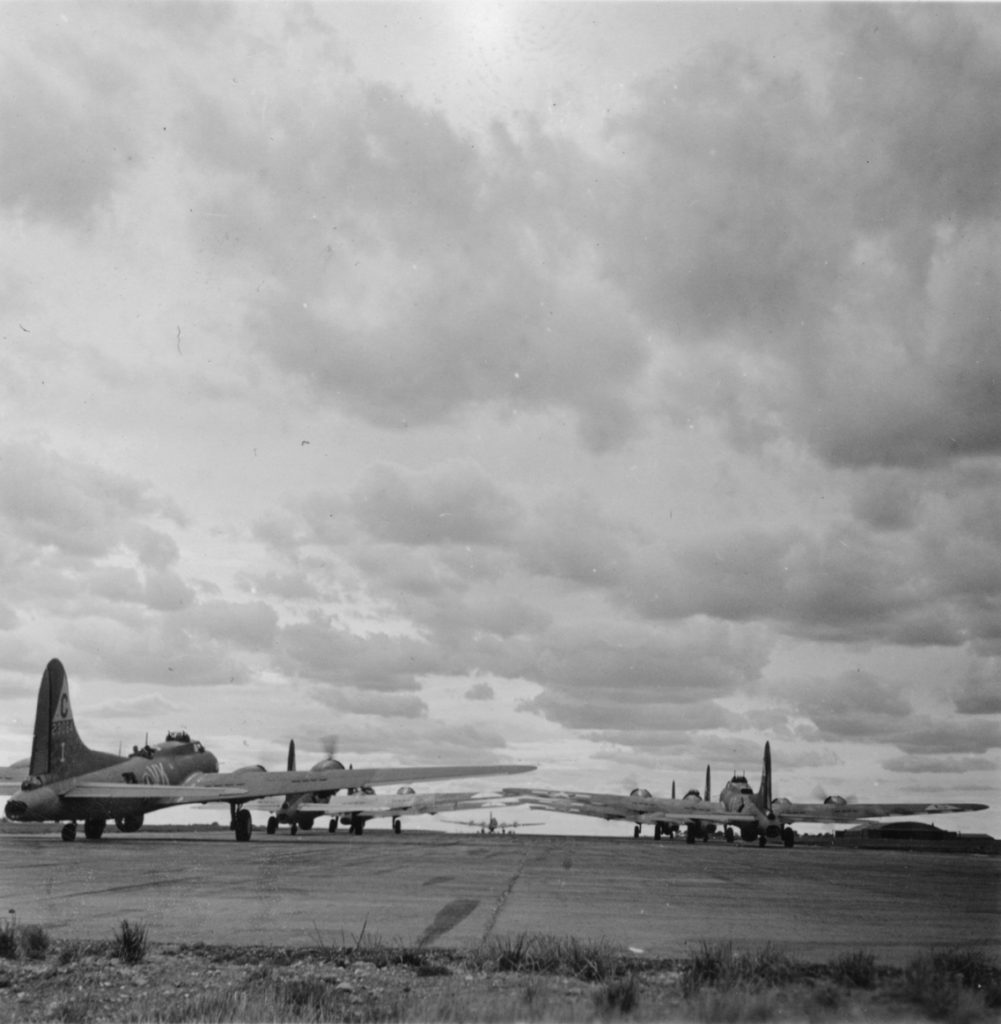
B-17s of the 303BG line up for takeoff on 27 August 1943.
The 303BG is the lead group this day, with CG 1BW BG Robert B. Williams flying aboard Vicious Virgin (42-4341). The 303BG loses a single bomber, Shangrila Li’l (42-29754) which explodes due to a flak hit in her bombbay. Three of her crew are killed while the others bail out and are taken prisoner.

A post-strike reconnaissance photo of the Blockhaus d’Éperlecques taken on 29 August 1943.
384BG after-action reports complain of ground haze and a target approach which had them flying toward the sun, blinding personnel from the glare.
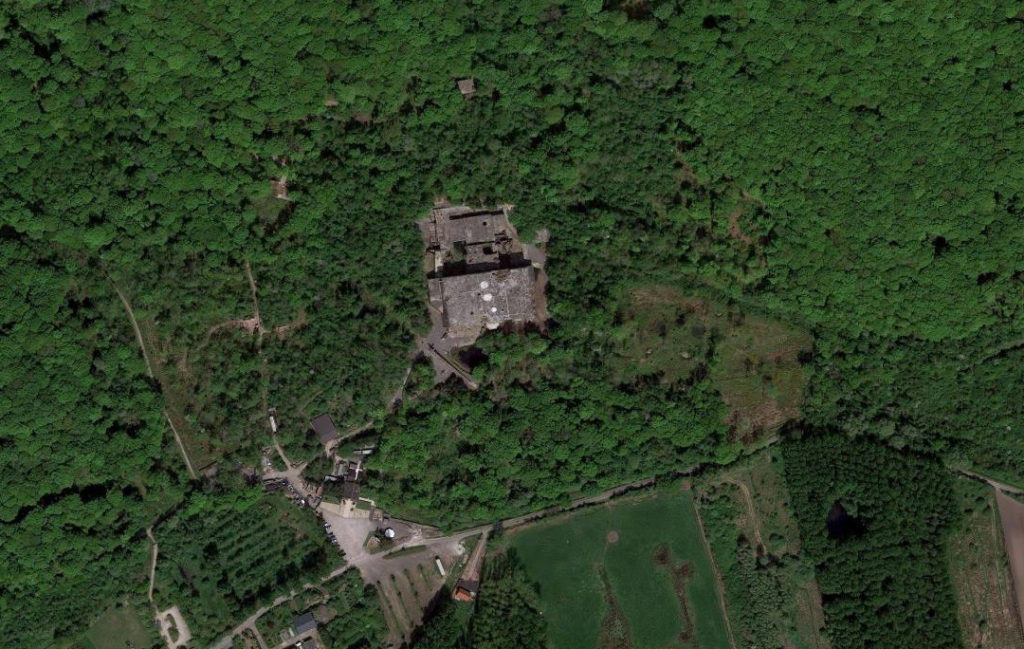
The Blockhaus d’Éperlecques as it appears today, facing north.
The facility was far enough inland to be safe from naval gunfire and was a mere sixteen miles from the Luftwaffe airfield at Saint Omer. As such, the US 8AF’s strike this day was launched with its groups flying in line-astern, with four US and 23 RAF squadrons providing escort. After action reports particularly praise the RAF’s fighter cover this day.
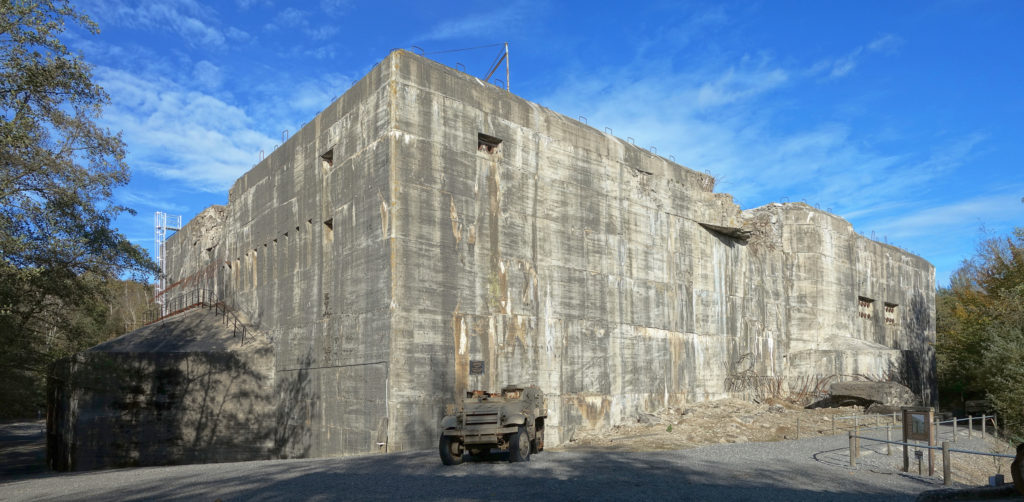
While privately owned, the Blockhaus d’Éperlecques is a protected property due to its historical significance. It has been an open museum since 1973.
You can check it out here.

